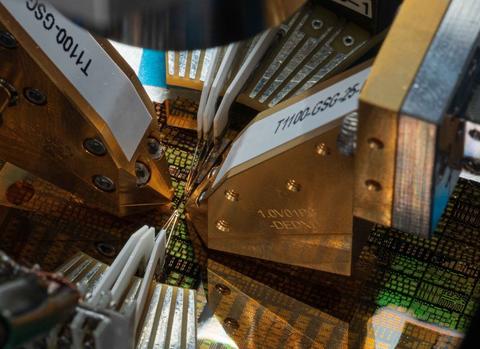Summary
U.S. innovation and industrial competitiveness rely on NIST to provide world class traceability to the International System of Units (SI) and to advance electromagnetic measurement science, standards, and technology in support of U.S. communications, microelectronics, sensors, and manufacturing, as well as trusted and resilient supply chains for these areas.
Description

This focus area develops theory, metrology, and standards for the technologies upon which the future of both wired and wireless communications depends. These developments are then leveraged to provide better measurement services to U.S. industry through extended frequency range, lowered uncertainty, new connection interfaces (on-wafer, new connector styles, over the air (OTA)), extended dynamic range, and direct traceability to the fully quantum SI. The work ranges from on-chip measurements of the transistors that generate communications signals, characterization of the wired interconnects and free-field channels and antennas through which these signals travel, the characterization of the integrated circuits that receive and process those signals, and the materials from which communications systems are made. CTL provides the fundamental technologies to quantifiably characterize microwave electronics and electronic materials, superconducting electronics, and emerging communication technologies, e.g., millimeter wave communications, quantum information systems, and free-space optical communications.
Projects and Programs:
Electromagnetic Traceability
Provision of traceability to the International System of Units (SI) through calibration services, standard reference materials, standard reference instruments, and best-practice guidance ensures the reliability of measurements worldwide by allowing them to be compared with established international standards with well-understood uncertainties. Validated methodologies for measurements are required for the design, development, and deployment of advanced communications systems.
-
In addition to providing Calibration Services to the Nation for fundamental RF free field parameters underpinning all wireless communications, the work advances the state of the art in free field metrology through the development of a new robotic antenna range, a new robotic field strength measurement facility, as well as advancing antenna theory, field sampling methods, signal processing, and Rydberg atom-based traceability to the fully quantum SI.
-
Traceable measurements of electromagnetic power, scattering parameters, thermal noise, and materials properties at microwave and millimeter wave frequencies and are critical for the development and deployment of new and existing wireless communications systems. Work in this area involves the development and evaluation of traceable primary standards and measurement services for the dissemination of the SI to the microwave and communications communities.
Over-the-Air Testing (OTA)
-
Fundamental measurement science to assess over OTA device performance in the presence of distortion, including electronic distortion (e.g., nonlinearity) and environmental distortion (e.g., multipath). This includes the development of test methods/uncertainties for system sensitivity, radiated power, and modulated signal fidelity. The results of this work informs industry-lead standards development for repeatable lab-based test under OTA conditions.
Quantum Traceability for Communications
-
Exploits the quantum behavior of superconducting Josephson junctions and materials to develop novel superconducting electronic devices, circuits, and systems to improve measurement techniques and standards for fundamental metrology, such as for dc and ac voltage, waveform synthesis, and for applications that require high-performance, such as energy-efficient advanced computing, quantum computing, test of high dynamic range RF components.
-
Rydberg atoms are highly sensitive to electric fields and, depending on the Rydberg state used, allow for detecting fields ranging from DC to THz with a single compact sensor. Furthermore, Rydberg-atom-based sensors can be used to quantify the electric field with traceability to the fully quantum SI. CTL is developing Rydberg-base sensor technologies for improved field strength probe calibrations, quantum traceable RF power measurements, and measurements of blackbody radiation, amongst other applications.

